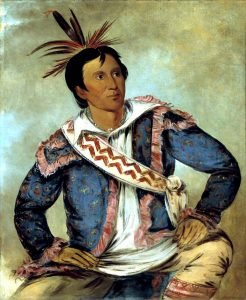
Choctaw Mixed Bloods and the Advent of Removal, was a dissertation written by Samuel James Wells 1 for his Master Degree in Arts.
Most studies of Indian-white relations in the Old Southwest either condemn federal and state policies as expansionist and racist or defend those policies as necessary and proper. Such approaches tend to paint the historical picture in dichotomous tones neglecting to analyze the subtle, positive relationships between Indians and whites that existed outside of confrontation. This dissertation addresses one such area concerning white countrymen and their mixed-blood offspring living with the Choctaw tribe before Removal.
Much of what transpired between the Choctaw nation and the United States government from 1795 until Choctaw Removal in 1830 was heavily affected by this group of white countryman and their Choctaw speaking children. The Chickasaw, Cherokee, and Creek experience was similar. There is also plentiful anecdotal evidence from the nineteenth century historians that countrymen and mixed bloods were commonplace in Indian tribes of Mississippi Territory. Indeed there exist several thousand names from government claims records and commission hearings, as well as genealogical evidence, which indicate a broad occurrence of mixed bloods, especially in the Choctaw tribe.
This study lists the names and families of the known mixed bloods and examines their role in tribal history, especially regarding land treaties during the Jeffersonian years preceding Removal. This study includes a database of over three thousand names of known and probable mixed bloods drawn from a wide range of sources and therefore has genealogical as well as historical value.
- An Affinity For Trade
- Choctaw Trade and Coexistence in the Nation
- Sample of Mixed Blood Ubiquity: Representative Family Histories
- Jefferson, Mixed Bloods and Frontier Defense
- From Alliance to Removal
- Removal and the Legacy
- Databases of Choctaw Mixed Blood Names
- Appendix A: Known and Probable Mixed Bloods
- Appendix B: Choctaw Mixed Bloods, 1831-33
- Appendix C: Probable Mixed-Blood Heads of Household, 1834
- List of Charts
- Anderson List of Mixed Bloods
- Brashears List of Mixed Bloods
- Cravat List of Mixed Bloods
- Durant List of Mixed Bloods
- Folsom List of Mixed Bloods
- Frazier List of Mixed Bloods
- Jones List of Mixed Blood
- Juzan List of Mixed Bloods
- Le Flore List of Mixed Bloods
- Nail List of Mixed Bloods
- Pitchlynn List of Mixed Bloods
- Choctaw Indian Treaty Signers, 1830
- Mixed Blood Captains 2 (See Note)
- List of Illustrations
Citations:
- Samuel James Wells was born July 18, 1836, at Biloxi, Mississippi, where he attended public and Parochial schools until 1954. He holds a Bachelor of Science degree with a major in American Studies, and a Master of Arts degree with a major in History from the University of Southern Mississippi.
His work experience includes twenty years of military service, four of which were spent as an instructor of recruits. He also as an instructor and teaching fellow at the University of Southern Mississippi from 1979 until 1987. During the same period he has published articles in several journals, winning the Kenneth R. Wesson award from the University of Alabama for an article in 1983, and co-edited a collection of studies on Choctaw Indians of Mississippi. He has acted in a consulting capacity for several projects of the Mississippi Band of Choctaw Indians and the Mowa Band of Choctaw Indians of Alabama. He has acted as a partner in an editorial and research consulting firm from 1982 to 1987.
He is a member of Kappa Delta Pi, National Education Honor Society: Phi Kappa Phi, national honor society; and Phi Alpha Theta, National Honor History Society.[
]
- In the process of putting this dissertation online it was discovered that pages 78 and 177a were missing. It was determined that the dissertation reader or printing plant must have mislaid the pages during their processing. It is agreed the pages must have been present when read by five different professors who didn’t sign their names to documents without careful scrutiny.
We feel those two pages are lost forever, as all other working copies eventually were destroyed. Dr Wells feels that the loss of page 78 won’t disrupt the train of thought because he is fairly repetitive in his arguments. The loss of the table is a sore point because notes have been destroyed that might have allowed for the rebuilding of the Mixed Blood Captains.
Several years ago we put the Armstrong Roll online, included with that roll were the following captains from various districts in the Mississippi Choctaw Nation:
- Captains from Leflore District
- Captains from Mushulatubbe District
- Captains from Nitachacha District
Please remember these are not the original lists Dr. Wells had with his dissertation.[
]
